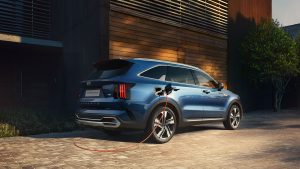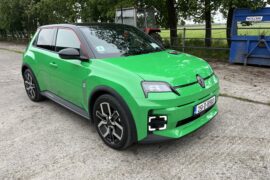Kia Motors has revealed the new Kia Sorento Plug-in Hybrid as an ultra-low emissions version of the brand’s flagship global SUV. The new variant claims to combine practicality with low running costs and high power, and broadens the appeal for the D-segment SUV. Sales commence in 2021 and Kia’s 7-Year, 150,000 km warranty is included.
The new Sorento Plug-in Hybrid is the second electrified model in the new Sorento line-up, and sits alongside the low-emissions Sorento Hybrid. The new variant combines a powerful turbocharged gasoline engine with a high capacity battery pack and high output electric motor, giving drivers the ability to complete shorter drives on all-electric, zero-emissions power.
The Plug-in Hybrid variant achieves this while maximising space and versatility, with the innovative platform that underpins the fourth-generation Sorento designed from the outset to accommodate electrified powertrains. The new platform and large body ensures the Plug-in Hybrid model retains the generous cabin and luggage space and five- and seven-seat layouts that define other models in the line-up.
High-power, low emissions
The Sorento Plug-in Hybrid isn’t just the lowest-emitting model in the Sorento line-up in Europe, but also the most powerful. The beating heart of its ‘turbo hybrid’ powertrain is its 1.6-litre T-GDi (turbocharged gasoline direct injection) engine, which, on its own, produces up to 180 ps and 265 Nm torque. The engine is paired with a high-capacity 13.8 kWh lithium-ion polymer battery pack and a powerful electric motor which produces 66.9 kW and 304 Nm torque.
Combined, these powertrain components enable the Sorento Plug-in Hybrid’s powertrain to produce up to 265 ps and 350 Nm torque.
The Sorento Plug-in Hybrid’s all-electric range will be sufficient to enable drivers to complete most short drives on electric power alone. Its all-electric range and CO2 emissions are pending homologation and will be confirmed by Kia closer to the car’s on-sale date.
Power is sent to all four wheels through a six-speed automatic transmission. The transmission allows the full power of the engine and motor to be transferred in parallel, with minimal loss of energy. The result is immediate acceleration responses at any speed, and direct access to available battery power at higher speeds.
A range of innovations throughout the powertrain also ensure the Sorento Plug-in Hybrid is the most advanced, efficient PHEV to-date from Kia. The new model represents Kia’s first use of an independent battery pack water-cooling system in a PHEV, ensuring optimal heat management and efficiency for the high-voltage battery pack. For the 66.9 kW electric motor, the rotor benefits from a new two-stage lamination process to reduce noise and vibration levels.
The engine features Kia’s latest ‘Smartstream’ innovations, including Continuously Variable Valve Duration technology, which regulates the duration that the intake valves open and close depending on driving conditions. This enables the engine to operate on different combustion cycles, seamlessly optimising engine performance and fuel efficiency.

Kia’s new midsized SUV platform, introduced with the fourth-generation Sorento and underpinning the new Plug-in Hybrid model, plays a key role in accommodating the new powertrain. Its innovative structure and layout maximises space for passengers and luggage, with the battery pack located beneath the floor of the cabin.
As a result, the Sorento Plug-in Hybrid offers generous space for up to five or seven passengers as its Hybrid and diesel counterparts. It also offers one of the largest cargo capacities in its class, with the larger battery back not taking up significant amounts of boot space – up to 809 litres (for seven-seat models) or 898 litres (five-seat models) with two rows of seats in place. In seven-seat models, with all seven seats in place, boot space is 175 litres (compared to 179 litres for its Hybrid counterpart).
Visually, Sorento Plug-in Hybrid models retain the same modern exterior design as other variants in the line-up, with ‘eco plug-in’ badges and a charging port on the rear quarters standing out as the only points of differentiation.
Inside, the cabin also remains largely unchanged, although the 12.3-inch fully-digital instrument cluster is redesigned, with new graphics and dials to provide drivers with a clear picture of the powertrain’s status. It enables drivers to keep track of the battery’s state of charge, as well as the flow of electric and gasoline power through the powertrain. The 10.25-inch touchscreen infotainment system also features new functionality to enable drivers to easily locate vehicle charging points on-the-go.





